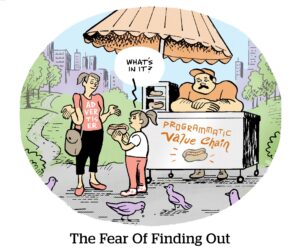Here’s today’s AdExchanger.com news round-up… Want it by email? Sign up here.
Pushing Forty
TikTok is pushing hard for adoption of its on-platform shopping product, particularly in North America.
Last month, it introduced a major Shopify backend integration, which lets brands plug influencers as affiliates and includes a payment system so users can buy without leaving the app or going to an in-app browser.
Another indicator of TikTok’s commerce commitment is that it is quietly paying for 40% of North American consumers’ first purchases.
Facebook did a similar thing in 2021, but covered 20%, and it was framed as a holiday sale. However, even years later, advertisers were surprised to see strange price disparities between their alleged sales and campaign ROAS, only to discover that the 2021 holiday promo just … never stopped running.
It’s a nifty trick, especially because neither Facebook nor TikTok touted the deal.
Users see a discount; the merchant gets a full-price sale. Neither is aware of it, but the 40% price gap becomes ROAS, like sprinkling magic dust on the campaign.
It only works for a spell since TikTok covers one purchase per user. But it head-fakes automated ad systems into crediting TikTok Shop with amazing ROAS. (H/t @fritz_hollywood)
A Feather In Your Cap
Are daily ad budgets so … yesterday? Taylor Holiday, CEO of the ecommerce agency Common Thread, tweeted a graph showing a brand’s cost-capped spending spikes. It’s a useful demonstration of how cost caps can help capture intent outside of the daily budgeting framework.
Cost caps are preset rules that dictate the amount advertisers are willing to spend per conversion or engagement. Sometimes a surge of demand may arrive on a Sunday, or a product goes wild on TikTok on a Wednesday. Advertisers don’t want to kibosh a surge of high-intent search and social traffic because of an arbitrary daily budget cap.
While cost caps mean wider spikes in ad spend, they should flatten out over time in terms of more profitable sales.
The problem is that unchecked cost caps could get out of hand if they’re converting so many sales that the brand’s cash runs dangerously low before it recoups the actual sales. Very high rates of product returns could also overwhelm.
Also, platforms mess up. Facebook advertisers were crushed in April when cost caps stopped working on a random Sunday and everyone’s budget went out the window without the controls in place.
Empty Nest
The Twitter advertising train wreck continues to crash along endlessly, never coming to a merciful stop.
The latest problems stem from Twitter’s Community Notes feature, a favorite of owner Elon Musk’s, The Wall Street Journal reports. Ads from Apple, Uber and Samsung have been “fact-checked” in a critical light by Community Notes, which are uploaded by Twitter subscribers with no humans or systems in place to make sure notes are valid. Mobile games are called out when the ad graphics exceed the real game.
Musk likes the notes feature because an outsized number of subscribers and people who sign up for the program support him, personally, and sometimes ding companies he opposes (like Apple).
Convincing advertisers to return despite all the ways Musk has turned them off is Linda Yaccarino’s problem.
But the even worse news is a report by Reuters that Twitter’s ad revenue has shrunk every month, measured year over year, since the acquisition. That means, even with the benefit of the 2022 election and the World Cup in November shortly after the acquisition, Twitter was still down from 2021.
The drop-off has likely worsened every month since.
But Wait, There’s More!
Apple’s ATT crackdown emboldened DTC marketers to reinvest in Meta, Google. [Digiday]
More evidence the streaming wars are (kinda) over: You can watch Warner Bros. Discovery’s “Dune” on Netflix. [Vox]
Mira Murati, the young CTO of OpenAI, is building ChatGPT and shaping the future. [Fortune]
Romanian startup Creatopy raises $10 million for creative ad production efficiency. [tech.eu]
Advertisers will spend $84 billion on ad fraud this year, per Juniper Research. [Marketing Brew]
















